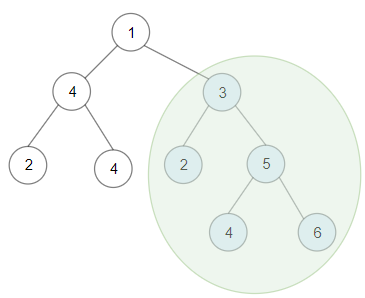Given a binary tree root, the task is to return the maximum sum of all keys of any sub-tree which is also a Binary Search Tree (BST).
Assume a BST is defined as follows:
Example 1:

Input: root = [1,4,3,2,4,2,5,null,null,null,null,null,null,4,6] Output: 20 Explanation: Maximum sum in a valid Binary search tree is obtained in root node with key equal to 3.
Example 2:

Input: root = [4,3,null,1,2] Output: 2 Explanation: Maximum sum in a valid Binary search tree is obtained in a single root node with key equal to 2.
Example 3:
Input: root = [-4,-2,-5] Output: 0 Explanation: All values are negatives. Return an empty BST.
Example 4:
Input: root = [2,1,3] Output: 6
Example 5:
Input: root = [5,4,8,3,null,6,3] Output: 7
Constraints:
40000 nodes..[-4 * 10^4 , 4 * 10^4].The core challenge of this problem is to identify the sub-trees within a given binary tree that are valid Binary Search Trees (BSTs) and then calculate the sum of their nodes. The goal is to find the maximum sum among all such BST sub-trees.
This problem is significant in various applications such as database indexing, memory management, and more, where efficient data retrieval and manipulation are crucial.
Potential pitfalls include incorrectly identifying BSTs and not handling edge cases like negative values or single-node trees.
To solve this problem, we need to traverse the tree and check each sub-tree to see if it is a valid BST. A naive approach would involve checking every possible sub-tree, but this would be highly inefficient.
Instead, we can use a post-order traversal (left-right-root) to gather information about each sub-tree and determine if it is a BST. This allows us to efficiently calculate the sum of nodes for valid BSTs and keep track of the maximum sum encountered.
The naive solution involves checking every possible sub-tree to see if it is a BST and then calculating the sum of its nodes. This approach is not optimal due to its high time complexity.
The optimized solution uses a post-order traversal to gather information about each sub-tree. For each node, we check if its left and right sub-trees are BSTs and if the current node satisfies the BST properties. If it does, we calculate the sum of the current sub-tree and update the maximum sum if necessary.
Here is a step-by-step breakdown of the optimized algorithm:
Below is the JavaScript implementation of the optimized solution:
// Definition for a binary tree node.
function TreeNode(val, left, right) {
this.val = (val===undefined ? 0 : val)
this.left = (left===undefined ? null : left)
this.right = (right===undefined ? null : right)
}
function maxSumBST(root) {
let maxSum = 0;
function postOrder(node) {
if (!node) return [true, 0, Infinity, -Infinity];
const [leftIsBST, leftSum, leftMin, leftMax] = postOrder(node.left);
const [rightIsBST, rightSum, rightMin, rightMax] = postOrder(node.right);
if (leftIsBST && rightIsBST && node.val > leftMax && node.val < rightMin) {
const sum = node.val + leftSum + rightSum;
maxSum = Math.max(maxSum, sum);
return [true, sum, Math.min(node.val, leftMin), Math.max(node.val, rightMax)];
} else {
return [false, 0, 0, 0];
}
}
postOrder(root);
return maxSum;
}
// Example usage:
const root = new TreeNode(1,
new TreeNode(4,
new TreeNode(2),
new TreeNode(4)
),
new TreeNode(3,
new TreeNode(2),
new TreeNode(5,
new TreeNode(4),
new TreeNode(6)
)
)
);
console.log(maxSumBST(root)); // Output: 20
The time complexity of the optimized solution is O(n), where n is the number of nodes in the tree. This is because we visit each node exactly once during the post-order traversal.
The space complexity is O(h), where h is the height of the tree. This is due to the recursive call stack used during the traversal.
Potential edge cases include:
Testing for these edge cases ensures the robustness of the solution.
To test the solution comprehensively, consider the following test cases:
Using a testing framework like Jest can help automate and manage these tests effectively.
When approaching such problems, consider the following tips:
In this blog post, we discussed the problem of finding the maximum sum of keys in any sub-tree of a binary tree that is also a BST. We explored a naive solution and an optimized solution using post-order traversal. We also analyzed the complexity, considered edge cases, and provided testing strategies.
Understanding and solving such problems is crucial for developing efficient algorithms and improving problem-solving skills. Practice and exploration of similar problems can further enhance these skills.
For further reading and practice, consider the following resources:
Our interactive tutorials and AI-assisted learning will help you master problem-solving skills and teach you the algorithms to know for coding interviews.
Start Coding for FREE